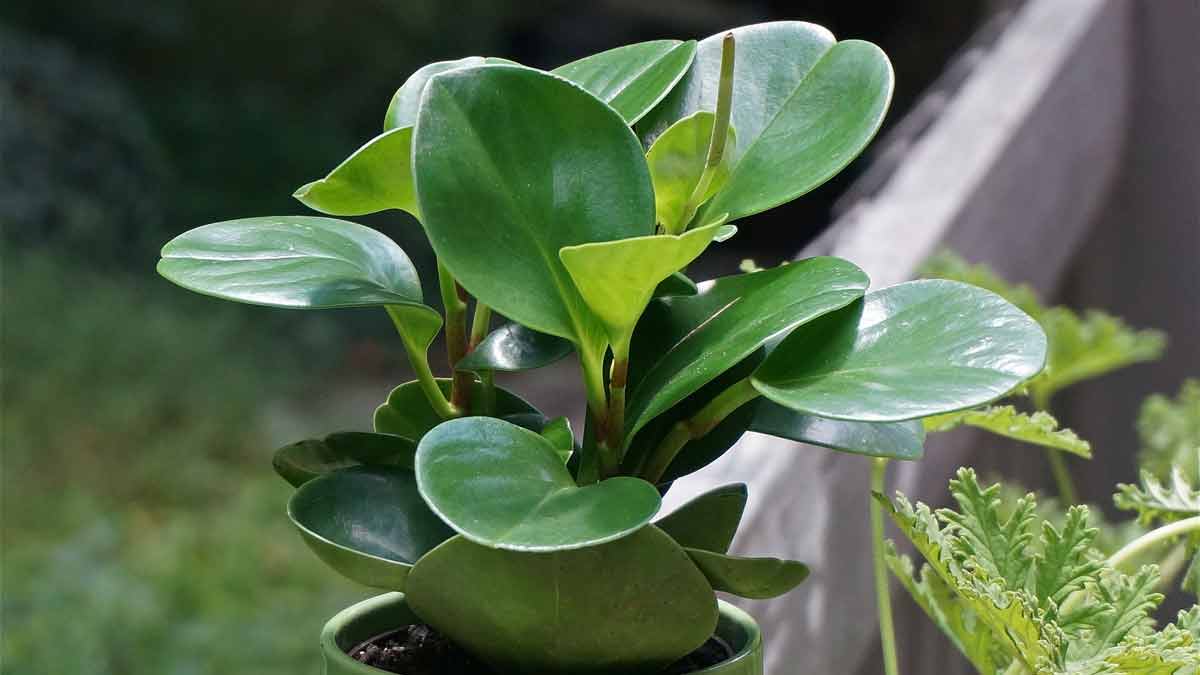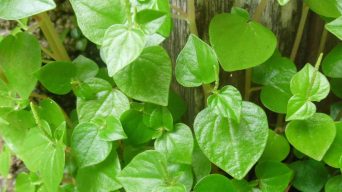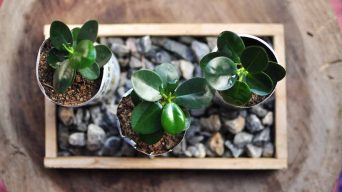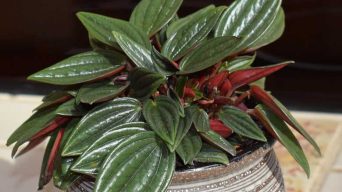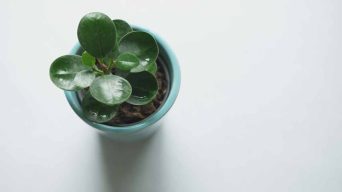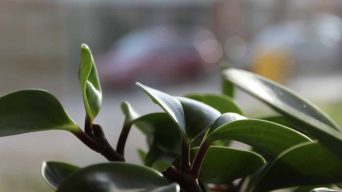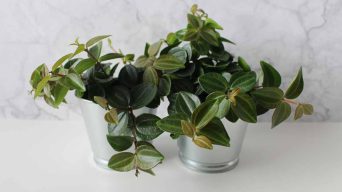Key Takeaways
- Peperomia plants thrive in environments with high humidity levels due to their natural tropical habitat.
- Ideal humidity ranges for different Peperomia varieties vary but fall between 40%-60%.
- Various methods can increase humidity levels, such as misting, using pebble trays, grouping plants, and using humidifiers.
- Monitoring soil moisture level is crucial to prevent overwatering or underwatering, which could negatively affect the plant’s growth.
Peperomia plants, popular and versatile tropical houseplants, are loved by many for their vibrant foliage and low-maintenance care.
These enticing beauties come in various colors, shapes, and sizes that can enhance your living space while purifying the air.
In this guide to Peperomia plants and humidity, we’ll dive deep into understanding their relationship with humidity levels to ensure your plant thrives in its environment.
Understanding Peperomia Plants And Humidity
Peperomia plants, native to tropical and subtropical regions, are a diverse group of popular houseplants known for their unique foliage and low-maintenance needs.
With over 1,500 species ranging in various shapes, sizes, and colors, they offer plant enthusiasts many options.
Some well-loved varieties include the Watermelon Peperomia (Peperomia argyreia), Baby Rubber Plant (Peperomia obtusifolia), and Emerald Ripple Peperomia (Peperomia caperata).
These charming plants boast intriguing leaf patterns and textures and exhibit attractive flower spikes that lack a perianth – setting them apart from other flowering houseplants.
Relationship Between Humidity And Peperomia Plants
Peperomia plants, often called radiator plants or baby rubber plants, are native to tropical and subtropical regions in Central and South America.
These environments provide high humidity levels that help these shade-loving houseplants thrive.
The relationship between humidity and Peperomia plant growth is significant since many of these species possess succulent-like characteristics.
For example, some varieties, such as Peperomia obtusifolia or watermelon peperomia, have thick leaves that store water more efficiently than thinner-leaved cultivars.
Plant owners must understand that inadequate humidity may lead to issues like leaf curling, drooping foliage, and stunted growth.
On the other hand, excessive moisture might also invite mold growth on soil surfaces or cause rotting problems if improper watering techniques and well-draining potting mixtures are not managed correctly.
Ideal Humidity Levels For Peperomia Plants
Peperomia plants require moderate to high humidity levels to thrive.
However, it’s important to remember that different varieties may have different preferences.
Optimal Humidity Ranges For Different Peperomia Varieties
Understanding the optimal humidity ranges for different Peperomia varieties is essential for plant owners who want to keep their plants healthy and thriving.
Below is a table detailing the ideal humidity levels for various Peperomia species.
| Peperomia Variety | Optimal Humidity Range |
|---|---|
| Peperomia caperata | 40% – 50% |
| Peperomia caperata rosso | 40% – 50% |
| Peperomia obtusifolia | 40% – 50% |
| Peperomia puteolata | 40% – 50% |
| Peperomia prostrata | 50% – 60% |
| Peperomia rubella | 50% – 60% |
| Peperomia scandens | 40% – 50% |
| Peperomia serpens | 50% – 60% |
It’s crucial to monitor and adjust the humidity levels according to the specific needs of your Peperomia variety.
This will ensure that your plants grow well and exhibit their full beauty.
Keep in mind that while some Peperomia plants thrive in high humidity, most are tolerant of moderate levels, making them a versatile and low-maintenance choice for plant owners.
Effects Of High And Low Humidity On Peperomia Plants
The amount of moisture in the air can significantly affect the health and growth of Peperomia plants.
High humidity levels can cause excessive water retention, leading to soggy soil and root rot.
On the other hand, low humidity levels can result in dehydration and wilting of leaves.
Maintaining a balance between high and low humidity is essential to prevent these adverse effects on your Peperomia plant.
For instance, plants with thick or succulent leaves can tolerate lower humidity levels than those with thinner leaves, such as the Watermelon Peperomia or Peperomia Obtusifolia variegata.
How To Increase Humidity For Peperomia Plants
If you want to raise the humidity level for your Peperomia plants, there are a few ways to do it.
You can use a spray bottle to mist the leaves frequently, place the plants on a tray of pebbles filled with water, group them to create a humid environment, use a humidifier in the room they are in, and monitor moisture levels with a hygrometer.
Misting Leaves
Misting leaves is one effective way to increase humidity levels for your Peperomia plants.
It involves spraying water directly onto the foliage, which creates a fine mist that settles on the leaves and helps to hydrate them.
Here are a few tips for misting your Peperomia plants:
- Use room temperature water when misting your plants. Cold water can shock the leaves and cause damage.
- Misting twice a day is recommended for Peperomia plants that need high humidity levels.
- Avoid misting in the evening, as this can leave water droplets on the leaves overnight, encouraging fungal growth.
- Use a spray bottle with a fine mist setting to avoid damaging the leaves with too much force.
Make sure not to rely solely on misting if you live in an area with very low humidity levels since other methods may be more effective at raising humidity over time.
Using A Pebble Tray
Increase the humidity around your Peperomia plants by using a pebble tray.
Here’s how:
- Fill a shallow tray or dish with pebbles.
- Add water to just below the surface of the pebbles.
- Place the plant pot on top of the pebbles in the tray.
- The roots shouldn’t soak in water but should be close enough to benefit from the humidity the evaporating water creates.
- Ensure you frequently check and refill the water in the tray to keep it optimal for your Peperomia plants.
Using a pebble tray is an inexpensive and easy way to increase humidity levels and help your Peperomia plants thrive indoors.
Alongside misting leaves or using humidifiers, this method creates a consistent humidity level around your plants without overwatering them.
Grouping Plants
Grouping your Peperomia plants can be a simple yet effective way to increase humidity levels and promote healthy growth.
This method works best for less-succulent varieties of Peperomia that tolerate higher moisture levels.
Here are some tips for grouping your Peperomia plants:
- Choose plants with similar humidity requirements, so they can benefit from being grouped.
- Place the plants in a tray or container with moist soil or pebbles to create a more humid microclimate.
- Position the plants close enough to make a canopy effect, allowing them to share moisture through transpiration.
- Rotate your plants regularly so that each plant receives adequate light and moisture.
- Check the soil periodically and water only when dry to avoid over-watering and root rot.
Grouping your Peperomia plants is an excellent low-cost way to improve air quality around your indoor garden while keeping your plants healthy and thriving.
Using A Humidifier
A humidifier is one effective method to increase humidity levels for your Peperomia plants.
Here are some steps to follow:
- Choose the Right Humidifier: Ensure you select a humidifier that can accommodate your indoor space. Different types and sizes of humidifiers include tabletop models and whole-house units.
- Position the Humidifier: Place the humidifier near your Peperomia plants, but avoid putting it too close to them as this could cause water droplets on the leaves.
- Set the Correct Humidity Level: Different varieties of Peperomia plants have specific humidity requirements; therefore, set your humidifier according to their needs. A hygrometer can help you track the humidity level effectively.
- Monitor Water Supply: Regularly check and refill your humidifier to maintain proper humidity levels. Make sure to use distilled or filtered water instead of tap water, as minerals in tap water can harm your plant’s foliage.
Using A Humidity Monitor
To ensure that your Peperomia plants get the right amount of humidity, consider investing in a hygrometer or humidity monitor.
This device measures the moisture level in the air and can help you determine if your plant needs more or less humidity.
Here are some tips for using a humidity monitor:
- Place the monitor near your Peperomia plant, but not too close.
- Check the readings regularly to ensure the humidity levels are within the optimal range for your specific Peperomia variety.
- Adjust your watering and misting schedule based on the readings you get from the monitor to maintain consistent humidity levels.
- If you notice that the humidity levels are consistently too low or high, consider adjusting where you place your plant or using additional methods to increase or decrease humidity.
Using a humidity monitor is an easy and reliable way to ensure that your Peperomia plants get the ideal amount of moisture in their environment.
With this tool, you can provide optimal growing conditions for your plants and help them thrive.
Final Thoughts
Peperomia plants thrive in environments with high humidity levels.
While they can tolerate moderate humidity, keeping the indoor environment between 40-50% is ideal for healthy growth.
Mist spraying, using pebble trays, and humidifiers are effective ways to increase humidity levels for your plant.
It’s important to monitor the soil moisture level and avoid overwatering or underwatering, as this can negatively impact your Peperomia plant’s growth.

